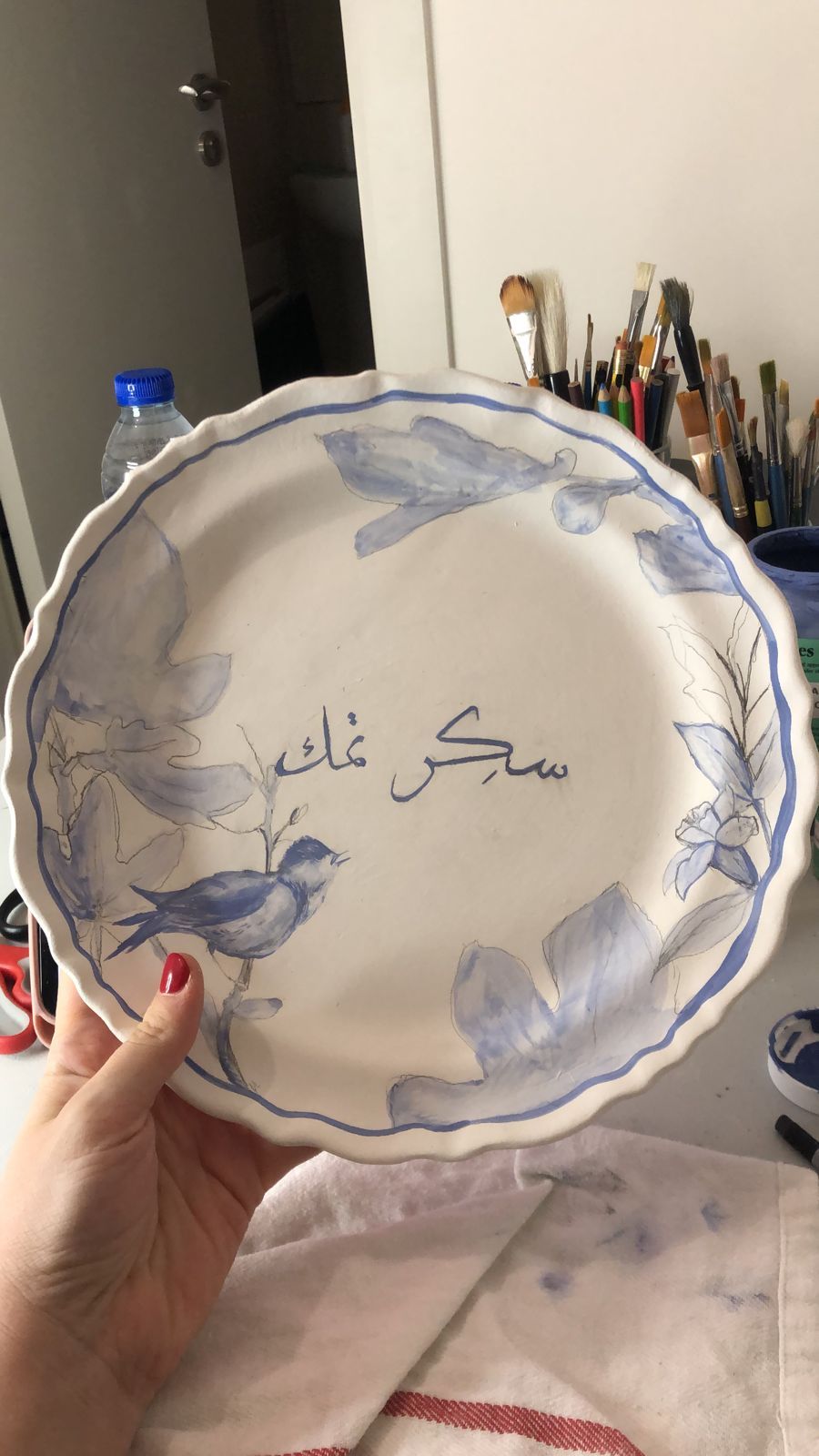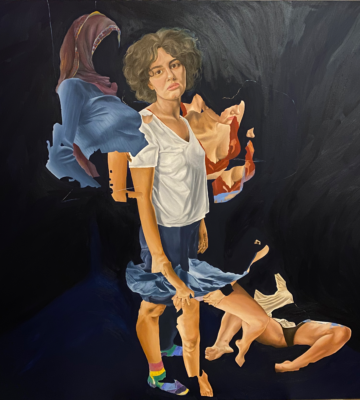Abu Dhabi Exhibition Reflects Conversations on Feminism in the Region

In Rania Jishi’s latest installation, “Dinner Is Served,” she uses handmade ceramic plates as a medium to convey the suppressed emotions of women in dinner table rituals. On a dining table, the Palestinian artist places a stack of beautiful, embellished plates. Upon closer inspection, each of the plates has a statement of rejection or anger imprinted on the delicate dinnerware.
“Shut your mouth,” says one.
“You’re dismissed” (an expression commonly used across the Levant, and having a deep association with sexism) is etched on another. By recreating scenarios of emotional abuse that women live with, Jishi attempts to “speak back to patriarchy.”
“The daughter, wife, or mother is forced to serve, oblige, accommodate, comfort, cushion, or baby a grown man,” she says. “Where normal channels of communication are lacking, the language of the patriarch is control, domination; and the language of the oppressed is anger, frustration.”
While the table is symbolic of nurturing or welcoming, the arrangement is uncomfortable. Shattered, unglazed, and unfinished plates are meant to communicate rejection or surrendering to the oppressed.
“There is no labor in setting them up. It says, ‘I am done.’”
Jishi’s installation is one of the 26 artworks currently on display at Abu Dhabi’s Warehouse421, an arts and design center dedicated to showcasing and supporting regional talent. Curated by Sara bin Safwan and Sarah AlAgroobi, the exhibition, titled “As We Gaze Upon Her,” is a first of its kind in the UAE.
The exhibition reflects on ongoing ideas and conversations on feminism and female experiences in the West Asia, North Africa, and South Asia (WANASA) region. For instance, Amina Yahia, an Egyptian multidisciplinary artist, uses a canvas painting to highlight the events that unfolded in the country last year. In the summer of 2020, Egypt witnessed a mass awakening around sexual assault. Describing the painting as a “nonlinear timeline,” Yahia draws on these events to interrogate misogyny, the male gaze, and objectification. The layered painting features fragmented female forms wearing “modest” and “immodest” clothing — terms that are often used to justify sexual crimes.

Speaking on the inspiration for the exhibition, co-curator Safwan explains, “It attempts to expand the notion of ‘woman,’ as it is often constrained by social, cultural, and existential insecurities.”
The exhibition includes five chapters, each using the body as a visual reference: subverting the gaze, the masquerade (representing performativity — the effort one goes through every day in order to conform to society’s standards), vindication of the body, difference as incompleteness (looking at gender binaries), and, lastly, dysfunctional societal norms and how one navigates through them.
In her experience of working as an artist in the region, Safwan has come across women who do not relate to Orientalist ideas of feminism because of the stigma that the label carries. Instead, the curators use “womanhood” as an approachable idea to operate with and also to explore the coming-of-age experiences of young women in the region.
As a first step toward clear and concise representation, the team created a glossary to accompany the exhibition. They redefined terms like patriarchy, misogyny, and Orientalism in contextual relevance to the region.
“We took these terms and translated them,” says Safwan. “To be able to do that, implement and normalize this language, was empowering.”
AlAgroobi explains how they have attempted to create an intersectional exhibition that recenters the understanding of womanhood and justice for all marginalized groups in a regional context. “When we talk about spaces, women dominate private and domestic spaces and men dominate public spaces, but that may have nothing to do with being ‘oppressed.’”
“There are so many cultural nuances that operate, and these intersectionalities are important because they help clarify and reframe,” she adds.
The exhibition also examines the intersectionalities of race, migration, and class. For instance, Augustine Paredes’ existential self-portraits are a direct response to displaced migration from his native Philippines to the city of Dubai. Paredes juxtaposes the relationship of his body to the tightness of space. As he curls and slouches into a fetal position, he centers his disassociation and fragmentation to gender, identity, and sexuality. Through these intimate moments, he draws parallels between the migratory experience and self-identity.
In another installation, London-based Kurdish artist Evar Hussayni displays archival photographs of Kurdish women that move away from the usual narrative; beyond politicized identities of being war-stricken, resilient, and defiant. Set against the black and white fabric of a keffiyeh (which, in itself, is a symbol of resistance), they are presented as everyday women sharing the joys of family and community. Hussayni questions the methods of archival practice and, ultimately, who is in control of narrative of history under colonial struggles.
While the exhibition draws on regional elements, it is universal in the artists’ personal stories and intimate experiences, for example, how their bodies are viewed or how they are expected to conform to societal standards.
“In this aspect, it is very much universal,” says Safwan.
The curators hope the exhibition will be a starting point for conversations on how the region’s women define and shape feminism. “There has been such a thirst and demand for these kinds of conversations to happen,” says Safwan. “We are very keen to see what this conversation will mean outside of the context of the region because it is reclaiming a narrative — their stories, for them and by them.”
More articles by Category: Arts and culture, International
More articles by Tag: Middle East and North Africa, Art


























